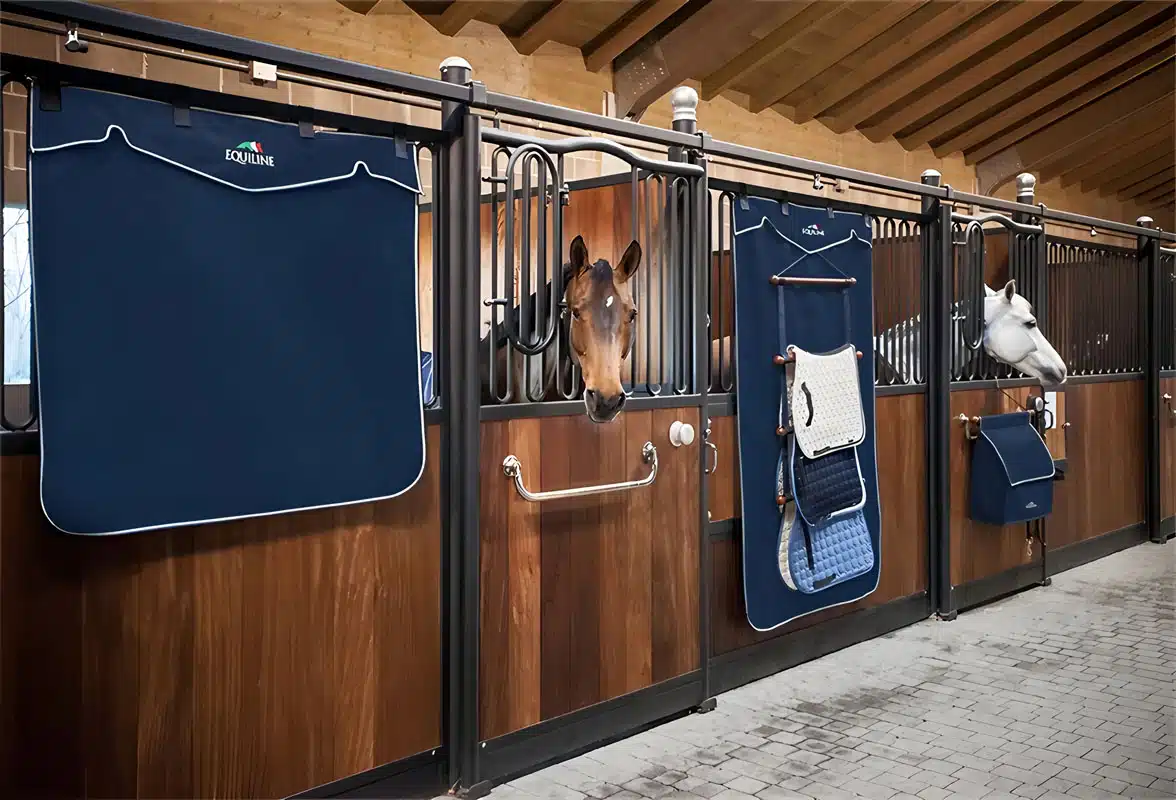For horse owners in bushfire-prone regions of Australia, stable safety is not optional—it protects both animals and valuable assets. Drawing on industry best practice, this guide shows how to combine ember-resistant materials such as steel and HDPE panels with strategic ventilation, defensible space planning, and clear evacuation protocols. Implementing these measures equips you to safeguard horses and infrastructure when fire risk peaks.
Fire Risks in Australian Stables
Australian stables operate in fire-prone conditions shaped by climate, building materials, and equine management demands. In rural and bushfire zones, underestimating these risks can cost both valuable horses and major infrastructure. Knowing how fires start, how local factors intensify threats, and which prevention measures work enables targeted investment to protect assets and avoid disruption.

Primary Causes of Stable Fires
Improperly cured hay and bedding can self-heat and ignite; control moisture and rotate stock before it becomes unstable. Electrical faults from damaged wiring or corroded junctions are common—schedule qualified inspections. Heating units, lamps, and water heaters must follow strict use protocols. Ban smoking outside designated zones and control welding or grinding work to prevent stray sparks near combustible storage.
Bushfire Threats and Regional Vulnerabilities
In states like Victoria, extreme summer heat, high winds, and drought create direct bushfire exposure, with embers traveling many kilometers. Combustible cladding and timber frames in older stables compound the hazard. Lack of structured fire drills slows response and increases losses; incorporate ember-resistant materials and defensible perimeter planning into every build.
Consequences and Financial Impact of Stable Fires
Stable fires often destroy entire facilities and kill horses valued in the hundreds of thousands. Larger, more complex operations face rising rebuild costs, prolonged insurance negotiations, and reputational damage. Preventive investment safeguards both capital assets and the enterprise’s long-term stability.
Effective Fire Risk Management Strategies
Before fire season, clear vegetation and debris, remove combustible waste, and define defensible zones. Inspect electrical systems regularly and repair faults immediately. Centralize ignition control: limit heater use, enforce no-smoking rules, and keep machinery servicing away from hay or bedding. Train staff with a bushfire survival plan covering evacuation, horse handling, and communications—regular drills ensure readiness when conditions escalate.
Fire-Resistant Materials
In bushfire-prone regions of Australia, the construction materials chosen for horse stables directly impact animal safety, asset protection, and maintenance costs. Drawing on experience with demanding rural installations, priority should be given to materials that meet fire-resistance benchmarks while withstanding moisture, UV exposure, and heavy daily use. Below is a breakdown of proven options that deliver both protection and durability in equine environments.
PVC Panels
Modern PVC panels for stables have self-extinguishing properties that slow fire spread, providing critical response time in emergencies. Because PVC resists moisture absorption and is free of harmful chemicals, it avoids warping and mold, ensuring a safer environment for horses. In turn, facilities see fewer panel replacements and reduced repair downtime during peak operational periods. For builders, PVC’s lightweight profile streamlines handling and installation, cutting labor hours while its minimal maintenance requirements help control operating costs.
High-Density Polyethylene (HDPE) Panels
HDPE panels such as Stableflex and POLYGRAIN® combine UV resistance, impact strength, and built-in flame retardancy. In outdoor stables under intense Australian sunlight, they maintain integrity without fading or cracking. Quality HDPE’s flame-retardant additives reduce ignition risk—a critical factor in large complexes where fire can spread rapidly. Recyclable and rust-free, HDPE supports sustainability objectives and positions facilities ahead of regulatory changes while securing long-term safety and performance.
Steel Structures
Steel framing naturally resists fire, rot, and pests. Hot-dip galvanized frames retain strength for over 10 years even in coastal or high-humidity areas, reducing lifetime structural maintenance and avoiding costly rebuilds after extreme events. Steel’s load capacity supports heavier roofing and wall systems, adding stability in high wind or bushfire conditions, which protects valuable livestock and equipment while minimizing post-disaster insurance complications.
Precast Concrete Panels
Precast concrete offers premium fire and flood resistance, ideal for facilities prioritizing asset protection. Its dense composition blocks flame penetration and limits heat transfer, helping maintain safer interior temperatures during nearby fires. Combined with fabricated steel frames, it creates a robust shell that withstands cyclonic winds and severe bushfire exposure. While initial costs are higher, the long-term security and low replacement needs often justify the investment for discerning stable owners.

Additional Fire Safety Considerations
Material selection is only part of the plan. Install high-quality fire detection systems for early alerts and faster emergency response, and follow strict wiring standards to reduce ignition risks from faulty circuits. Situate tack and feed rooms away from main stables to separate high-combustion materials from livestock housing, cutting potential fuel sources and adding another layer of protection for animals and property.
Design for Safety
In bushfire-prone areas of Australia, stable design must directly protect horses, safeguard assets, and meet regulatory requirements. Specify high BAL-rated materials, precise airflow planning, and integrated fire mitigation from the start. Partner with proven suppliers and builders to ensure every structural, mechanical, and layout choice enhances safety without compromising durability or everyday usability.
Materials and Fire-Rated Wall Systems
Use wall systems certified for high BAL zones, such as Stramit’s Uniguard™ or precast concrete panels, to resist heat and stop flame spread. Select locally manufactured fire-resistant products like Bluescope or COLORBOND® steel, which withstand Australia’s climate and reduce corrosion and maintenance. Verify each specification against bushfire codes so your design delivers tested protection, not assumed resilience.
Ventilation and Heat Management
Plan airflow early to mitigate heat stress and smoke inhalation, both of which can harm horses faster than flames. Incorporate open bays, mesh or Dutch-style doors, and a minimum roof height of 2.5 meters per bay to keep temperatures down and clear smoke quickly. Strong ventilation safeguards animal health and speeds post-fire recovery.
Roofing and Guttering for Fire and Water Safety
Install steel roofing with high ember resistance, and design guttering to channel and capture rainwater efficiently. Seal and flash gaps to stop wind-driven ember entry. This approach addresses both fire risk above and water management below without adding maintenance complexity.
Stable Layout, Partitions, and Emergency Planning
Adopt modular layouts with secure partitions to control segregation in emergencies and reduce panic injuries. Align floor design for smooth daily workflow and swift evacuation when fire threatens. Train staff so evacuation routes are clear, unobstructed, and reinforced by the building’s structure—saving critical time under bushfire conditions.
Additional Safety Features and Compliance
Fit smoke detection and anti-rearing gates to prevent incidents before they escalate. Use reinforced frames and non-combustible, easy-clean surfaces for hygiene and fire resistance. Combine non-slip flooring with proper drainage to avoid injury during evacuations in adverse conditions. Ensure every feature meets local codes and reflects your property’s bushfire risk profile. Engage fire safety and equine welfare specialists early to confirm total compliance and resilience.
Durable Horse Stables Built for Every Climate
DB Stable crafts customizable, weather-resistant horse stables designed to ensure safety and comfort worldwide. From extreme heat to cold winters, our modular designs meet international quality and compliance standards with ease.

Australian Standards & Compliance
When building or upgrading a fire-resistant horse stable in Australia, integrate national and state safety requirements into your design from day one. These regulations shape material selection, layout, and systems to protect animals and property in bushfire zones. Retrofitting after construction almost always costs more and disrupts operations, so engage compliance checks early to keep projects on schedule.
Regulations Governing Fire-Resistant Stables
The National Construction Code and relevant Australian Standards dictate non-combustible materials, structural fire ratings, and mandatory safety installations for bushfire-prone regions. Secure approval by submitting designs and material specifications upfront. Consult local authorities early—delays from overlooked requirements can result in redesigns and costly stalls in progress.

Fire-Resistant Materials and Construction
Prioritise Australian-made structural steel and other non-combustible components for maximum resistance. Add defensive assets like steel or concrete fencing to contain fire spread between paddocks and stable blocks. These investments cut long-term maintenance and extend service life, particularly in rural areas facing seasonal fire threats.
Stable Design and Evacuation Safety
Match emergency exit sizing to facility scale: individual stall doors should measure at least 1.3 metres wide, and main aisles require a minimum 2 metres clearance for safe, rapid movement of horses. For larger complexes, install multiple exits with illuminated signage to aid evacuation when smoke reduces visibility—critical for survival in fast-moving fires.
Electrical and Fire Safety Systems
Install electrical wiring to Australian Standards and schedule routine inspections to minimise ignition risks. Fit dust-tolerant smoke detectors, sprinklers, and accessible fire extinguishers during construction to turn early warnings into actionable time. Integrating these systems from the outset avoids later retrofit costs and downtime.
Safe Storage and Defensible Space
Store hay, bedding, and chemicals in separate, ventilated sheds away from the stable. Maintain a 20–30 metre clear zone around buildings free of combustible materials, combine with a dependable onsite water supply, and keep firefighting gear ready to establish a strong defence against advancing fire fronts.

Consulting Experts and Regional Variations
Fire safety rules differ between states and facility types. Engage a technical consultant before construction to navigate local codes and tailor national standards to your site, preventing compliance missteps that halt work or trigger fines. This localised strategy ensures your stable’s design addresses real-world risks in its environment.
Emergency Plans
Fires in rural Australia escalate fast, leaving no margin for slow decisions. Owners and stable builders must act in advance — designing heat‑resistant structures and enforcing clear procedures to protect horses and people. Proactive preparation reduces operational downtime, safeguards assets, and preserves animal welfare when bushfires or stable fires occur.
Bushfire Survival Planning
Initiate survival planning months ahead of fire season. Identify safe districts such as showgrounds, sale yards, racetracks, or pony club grounds for early relocation. Secure temporary transport agreements to avoid last‑minute delays, and train horses to load and travel calmly. Plan multiple evacuation routes to mitigate road closures, and keep maps in accessible locations for staff and drivers.
On-Property Safe Areas
When evacuation is not viable, maintain a designated safe paddock or linked paddocks with gates locked open for unrestricted movement. Select areas that are large, short‑grazed, and close to a reliable water source such as a dam. Remove trees and flammable structures to reduce ignition risk. Sand arenas can be used if watered and cleared of debris.
Stable Fire Plans
Develop a stable‑specific fire plan with evacuation paths and assembly points located well away from buildings. Identify extinguisher stations, water access points, and first aid kits on a clearly marked layout diagram. Display diagrams both inside and outside the stable to enable quick action. Conduct multiple evacuation drills annually to ensure all handlers follow the plan without hesitation.
Communication and Coordination
Post emergency plans prominently, including fire brigade contacts and property maps. Brief every staff member, agistee, and resident on response procedures. Hold yearly coordination meetings with neighbouring properties and local horse organisations to pool resources and improve joint response capabilities.
Fire Hazard Reduction Measures
Lower fuel loads around stables with fire‑resistant plants and active grazing. Enforce visible no‑smoking rules. Keep water troughs and metal containers full to support rapid suppression. On high‑risk days, disconnect electricity, gas, and electric fences to eliminate hazards.
Horse Management During Fire
Remove rugs, synthetic gear, and metal buckles from horses to prevent heat injury. Move them immediately to the safe zone and secure doors to stop re‑entry into danger. Do not confine horses in small yards or buildings — open space improves survival chances.
Evacuation Sites and Agistment Arrangements
For off‑property agistment, formalise written evacuation agreements with landholders. Pre‑identify sites such as veterinary schools, racetracks, or equestrian centres that can accept horses quickly. Keep these contacts and site listings ready for immediate action when a threat is confirmed.
Emergency Response Protocols
Monitor weather and fire danger ratings closely. On Extreme, Severe, or Code Red days, relocate horses to safe areas before threats materialise. Maintain direct communication with emergency services for updates and instructions. Prioritise human safety — facilities and equipment are replaceable, lives are not.
FAQs About Fire Resistant Stables Australia
Horse owners operating in bushfire-prone Australian regions face high-stakes decisions about stable materials, layout, and compliance. This FAQ delivers actionable guidance to help you select designs and upgrades that safeguard livestock and protect capital investments.
What does the BAL rating mean for my stable design?
BAL ratings indicate the bushfire intensity your site is expected to face. Higher ratings demand more robust materials and designs. For stables, this typically means specifying non-combustible frames, heat-resistant wall panels, and eliminating gaps that allow ember penetration. Commission a site assessment before final design and partner with suppliers who can provide BAL-compliant certifications, streamlining council approvals and avoiding costly retrofits.
Is a steel stable safer than timber in a bushfire?
Steel frames outperform timber in fire conditions, resisting ignition and retaining structural strength far longer. Galvanized steel adds corrosion resistance, maintaining integrity after heat or moisture exposure. Treated timber offers limited fire resistance but remains vulnerable to prolonged flame contact. In high BAL zones, steel construction delivers superior insurance outcomes and lower lifetime maintenance demands.
How can I make my existing stable more fire-resistant?
Treat exposed timber with certified fire-retardant coatings, remove combustible materials within 20 meters, and install ember mesh over vents and gaps. When replacing doors or windows, specify fire-rated models designed for extreme heat. Phase upgrades strategically, prioritizing external surfaces and openings where fire spread is most likely to start.
What is ‘defensible space’ and how much do I need?
Defensible space is a cleared buffer that prevents direct flame contact. In Australia, 20 meters is common, but steep terrain or dense vegetation may require greater distances. Conduct quarterly vegetation clearance and adjust layouts seasonally. This buffer slows fire spread and provides a safe zone for firefighting operations around your stable.
Are there specific building codes for stables in bushfire zones?
AS 3959 outlines mandatory construction standards for bushfire-prone sites, including stables, with requirements tied to BAL ratings. Councils may impose additional setbacks or ember-resistant specifications. Engage builders experienced in both AS 3959 and local amendments to avoid project delays. Compliance ensures proven fire resilience and reduces future legal or insurance risks.
Protecting Horses and Property in Fire Conditions
In Australia’s bushfire zones, designing a fire-resistant stable means actively reducing ignition risk and ensuring the structure can withstand extreme heat. Use non-combustible frames, BAL-rated walls, and ember-proof fittings, and keep high-combustion materials well away from livestock housing.
Pair these measures with defensible space planning and drilled emergency procedures covering evacuation routes, safe zones, and communication protocols. Treat materials, layout, and plans as one integrated safety system to protect horses, safeguard assets, and sustain operations throughout fire season.










0 Comments